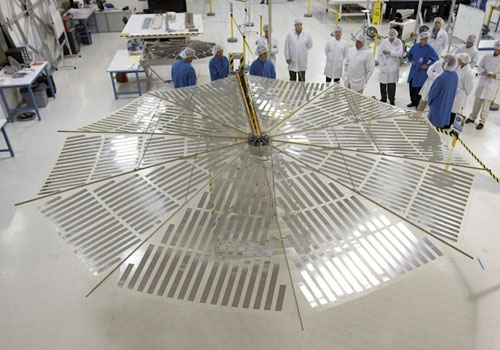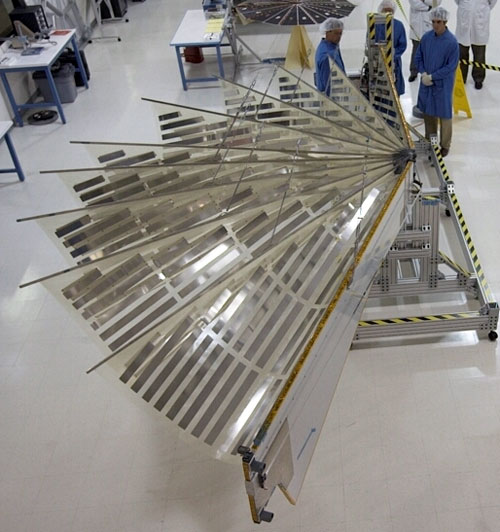NASA and ATK Successfully Deploy 18 Foot Diameter Solar Array for ST8 ProgramNASA and Alliant Techsystems (NYSE: ATK) have successfully concluded initial testing and deployment of the UltraFlex solar arrays for NASA's New Millennium Program Space Technology 8 Project (NMP ST8). The project will also produce data that can support Lockheed Martin Corporation (NYSE: LMT) in it is effort to develop the Orion crew exploration vehicle for NASA with the goal to safely transport astronauts to and from the International Space Station, the Moon and Mars.
The fabrication and deployment testing of the full-scale functioning UltraFlex wing hardware helped NASA, Lockheed Martin and ATK engineers address Orion design questions and reduce potential risks. Areas where data will be used are manufacturing, assembly, offload, mechanism operation and performance of deployment in Earth's gravity. Additionally, the UltraFlex solar cells were exposed to environmental testing to verify the UltraFlex solar blanket performance and survivability in expected launch and on-orbit environments.
The UltraFlex disk shaped solar arrays, which measure more than 18 feet (5.5 meters) in diameter, will provide power for Orion during its missions. The unique design provides solar power at less than half the weight of traditional rigid panel solar arrays.
ATK's UltraFlex arrays feature ultra-lightweight materials that provide high strength and stiffness, as well as compact stowage volume. Smaller scale versions are currently powering NASA's Phoenix Lander that has been on Mars since May 25. Due in part to the exceptional performance of the solar arrays, the 90-day mission life of the Mars lander has been extended three times. Power from the arrays has produced more power than pre-mission predictions. The additional power has allowed the surface team to extend the amount of operating hours for the science team.
"Solar array performance and weight are critical factors in the development of vehicles that will be traveling to the ISS and the moon," said Carl Marchetto, ATK Space Systems President. "The completion of these preliminary tests begins to demonstrate the critical functions and capability UltraFlex technology brings in support of the successful development of the Orion vehicle."
The two-part test validates the UltraFlex solar array's deployment reliability and acceleration capability -- up to 2.7G's -- as needed by NASA's Orion lunar mission. The data from the deployment and static load tests will be used in preliminary risk reduction activities focusing on the unique thermal, vacuum, and deployed loading environment the solar arrays will experience during actual missions.
ATK is under contract to NASA's Jet Propulsion Laboratory for the NMP ST8. The ST8 project's mission is to validate four new subsystem-level technologies, one of which is the UltraFlex Solar Arrays. The technology was selected for its promise in advancing NASA's most important future science missions, as so deemed by the science community of the U.S. and the world. NASA's Office of Space Science (OSS) and Office of Earth Science jointly established the New Millennium Program in 1995 -- an ambitious, exciting vision to speed up space exploration through the development and testing of leading-edge technologies.
ATK is a subcontractor to Lockheed Martin -- the prime contractor for NASA's Orion vehicle which will return humans to the moon and prepare for future voyages to other destinations in our solar system. Orion is an advanced spacecraft utilizing state-of-the-art technology and will be carried by NASA's Ares I launch vehicle. Ares I will use a single five segment first stage solid rocket booster, using flight proven technology from the twin boosters used to launch the space shuttle. ATK is the prime contractor for the Ares I first stage. A series of ground and flight tests are planned over the next several years that support accomplishing the first crew flight of Orion and Ares I, currently scheduled for 2015.
ATK is a premier aerospace and defense company with more than 17,000 employees in 21 states and approximately $4.6 billion in revenue.













